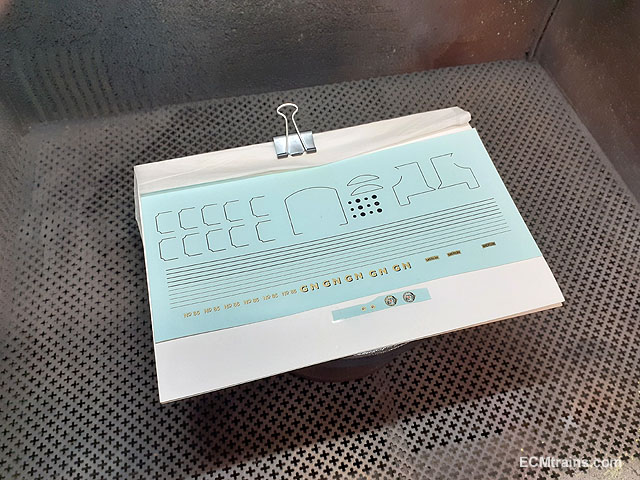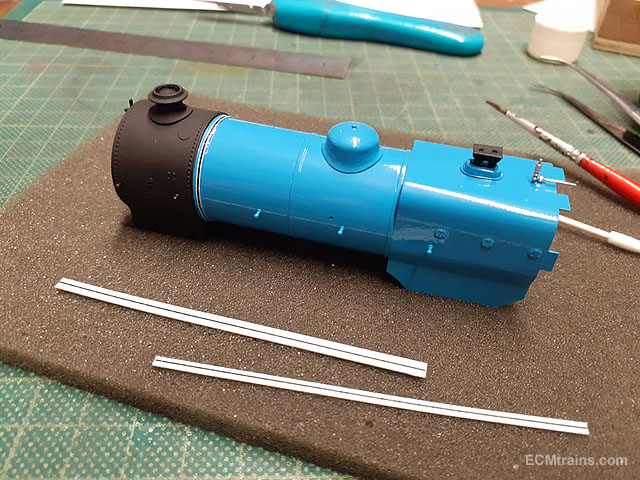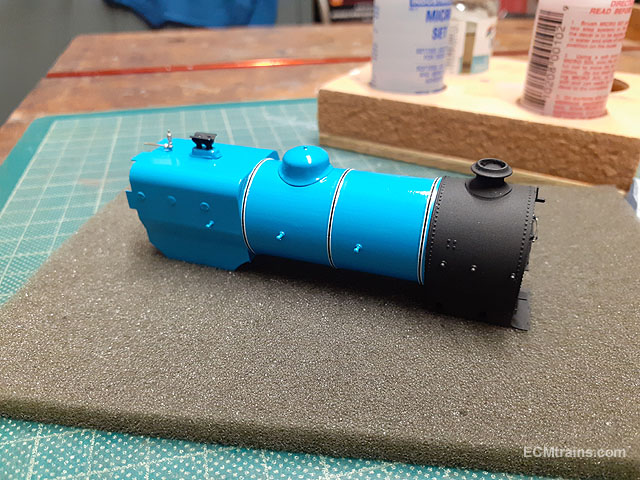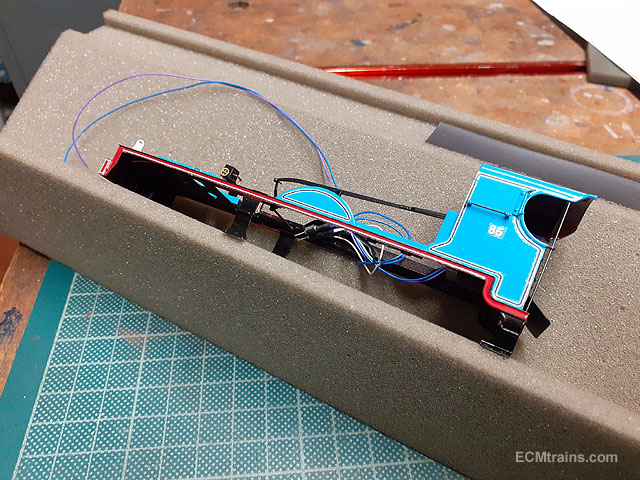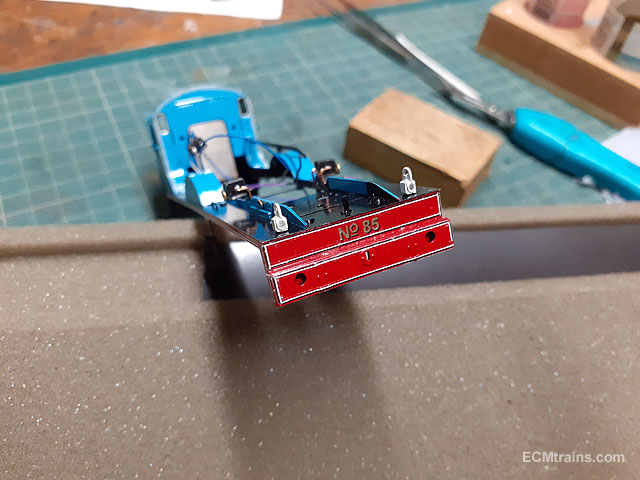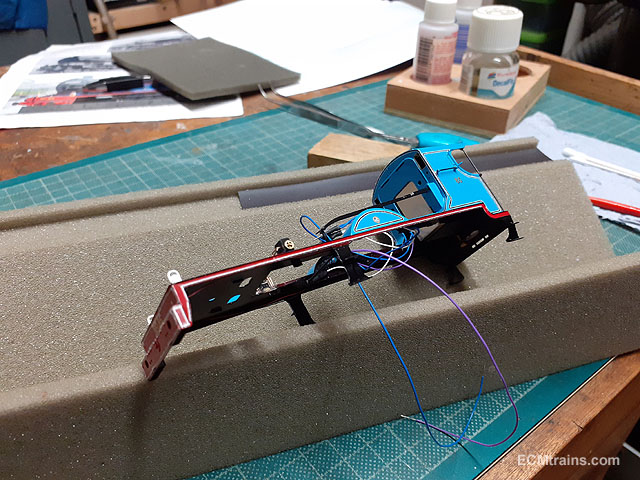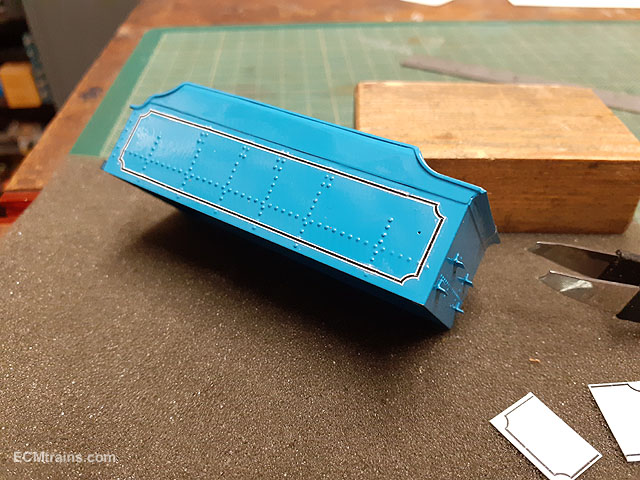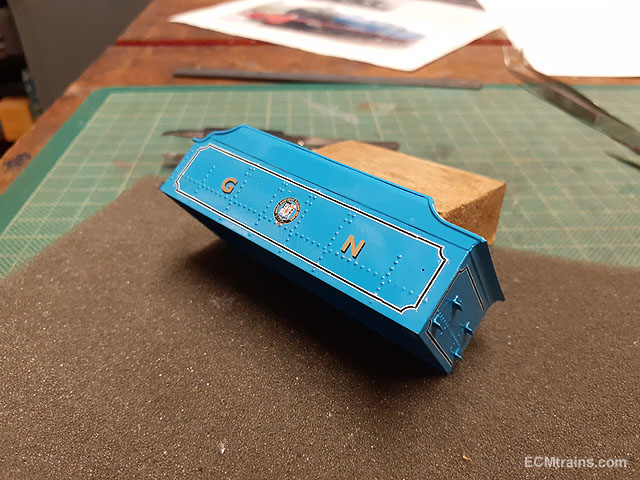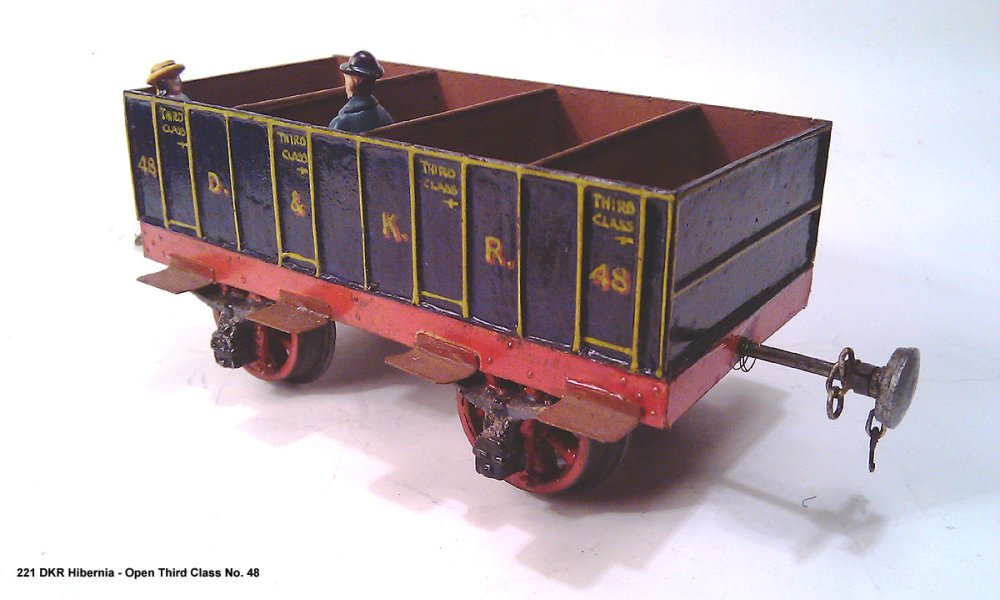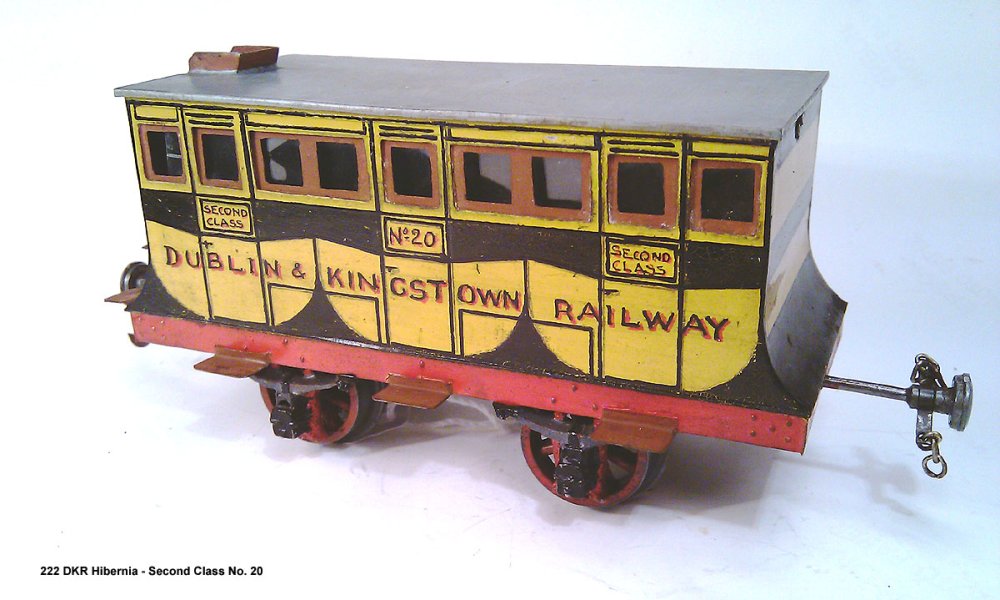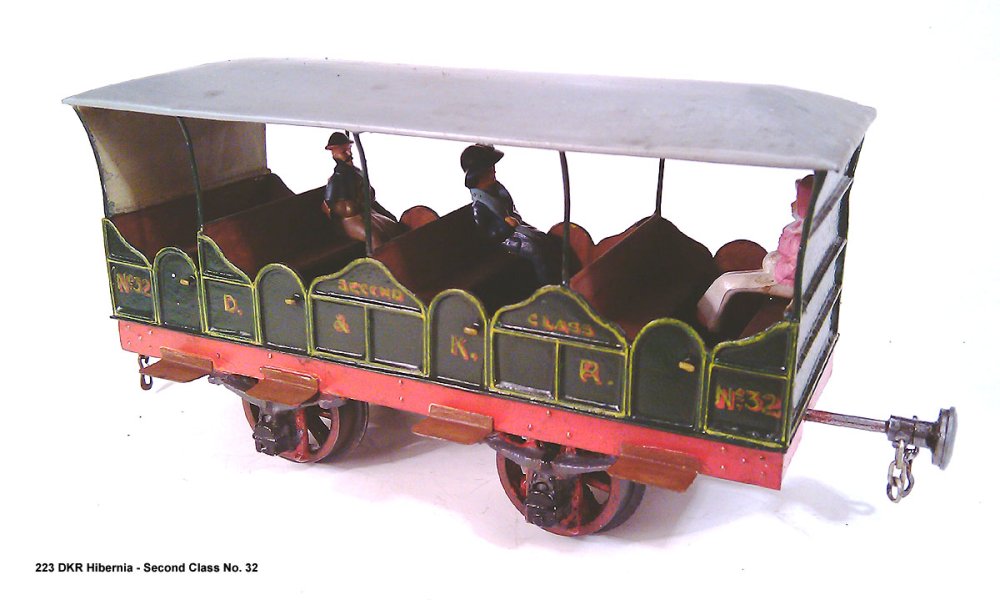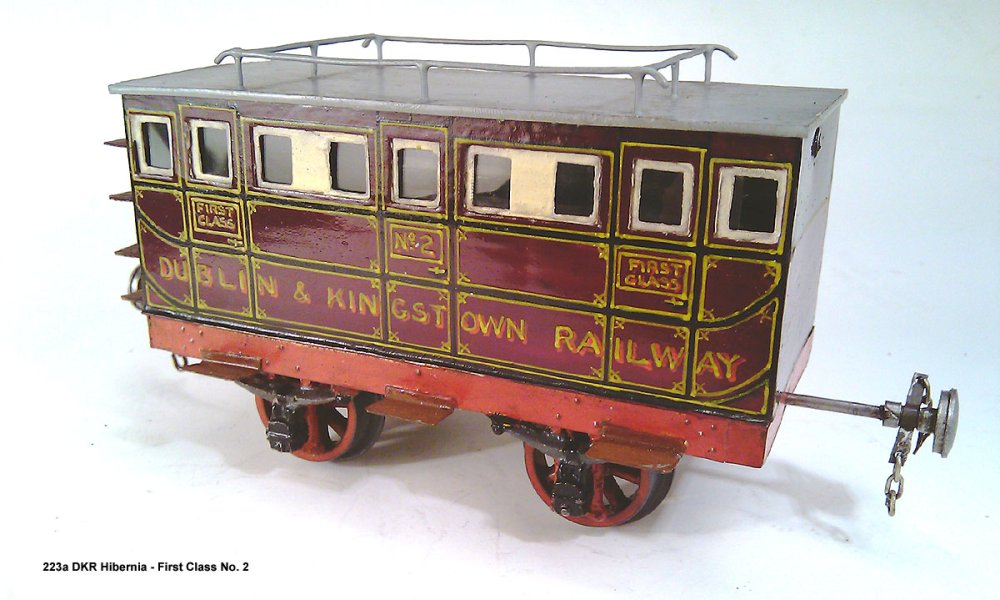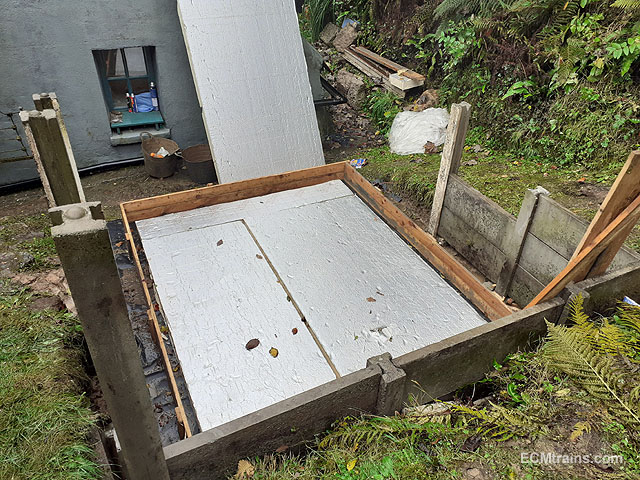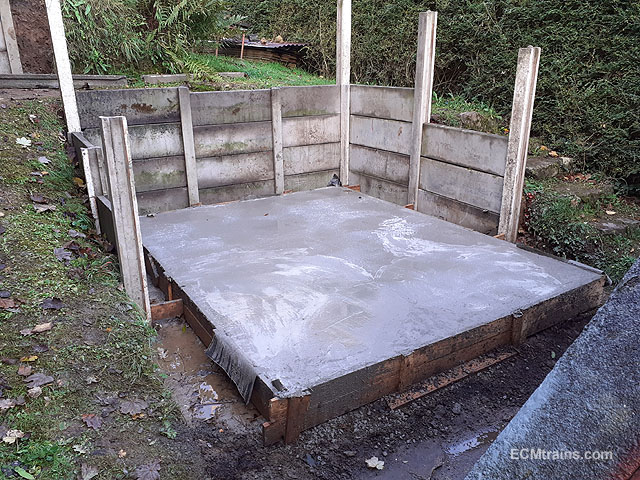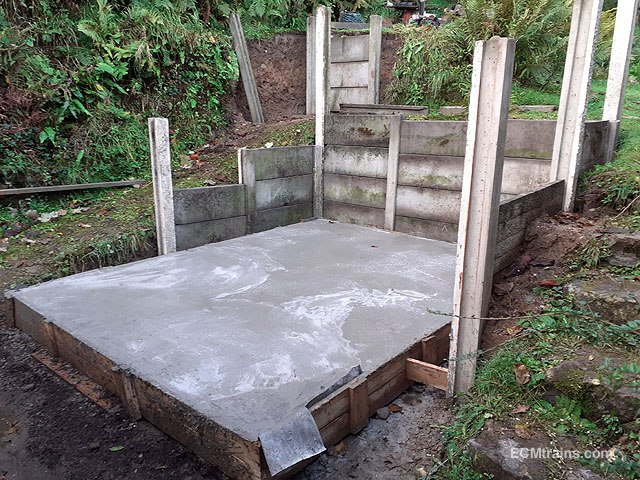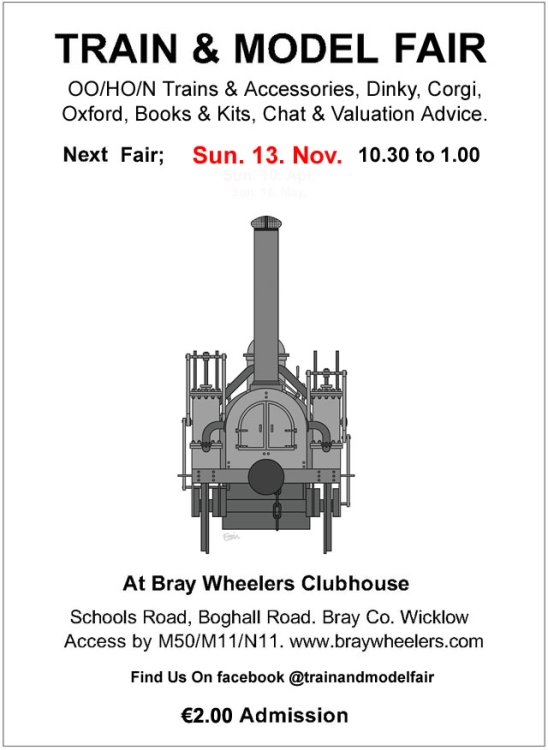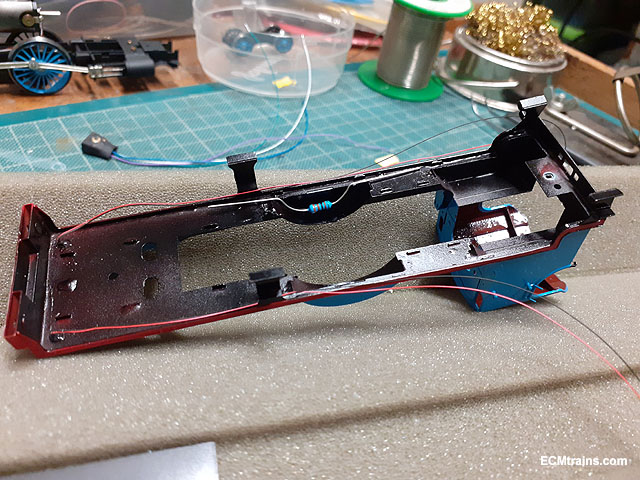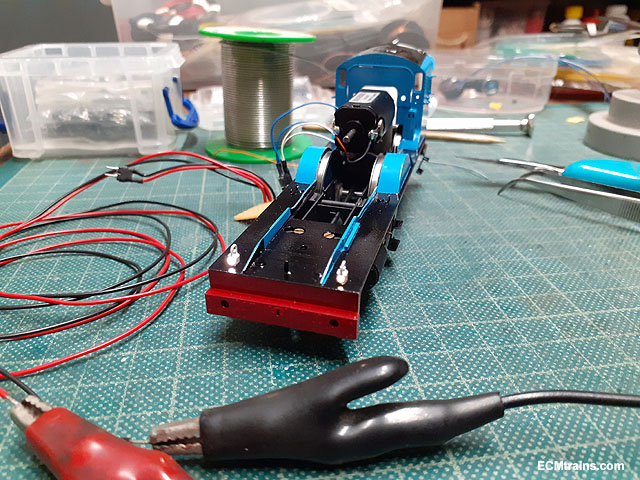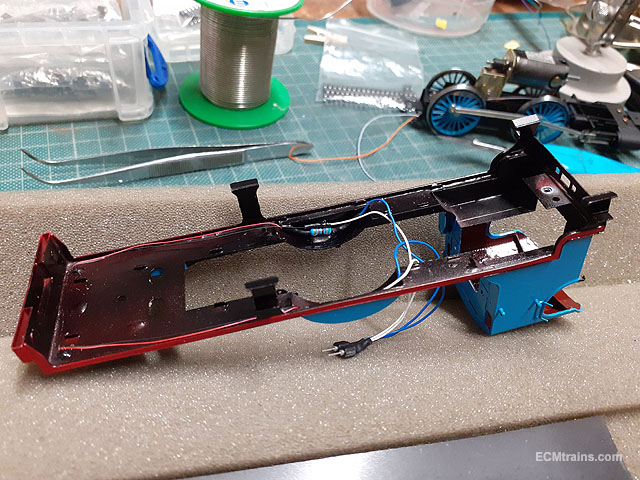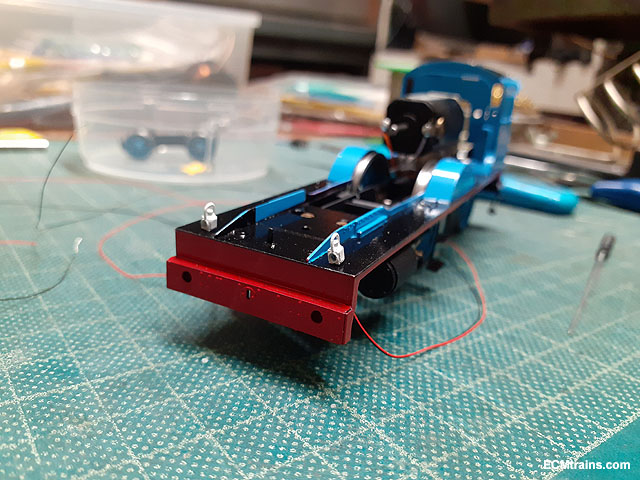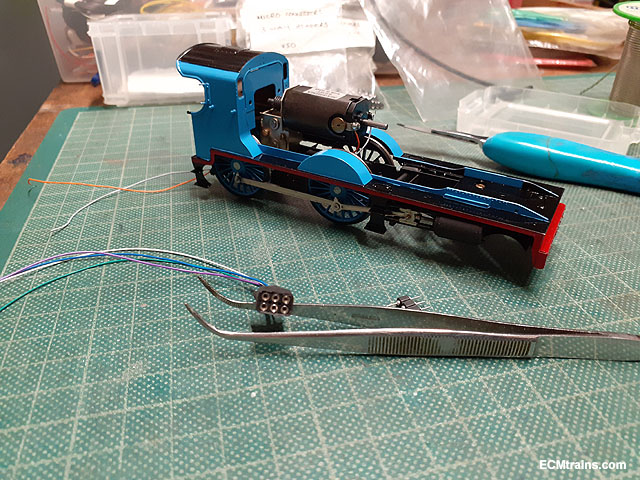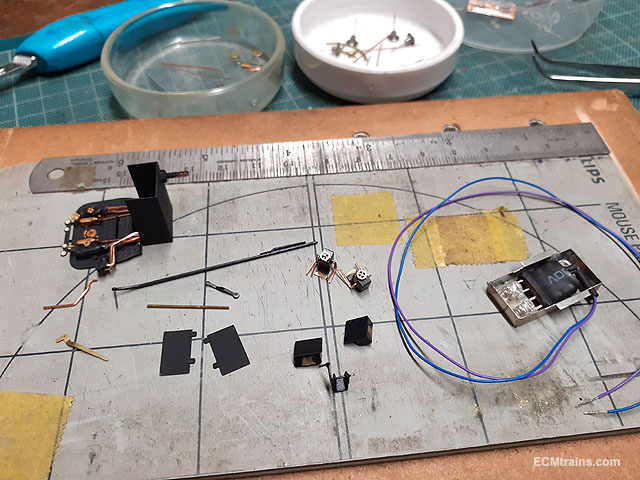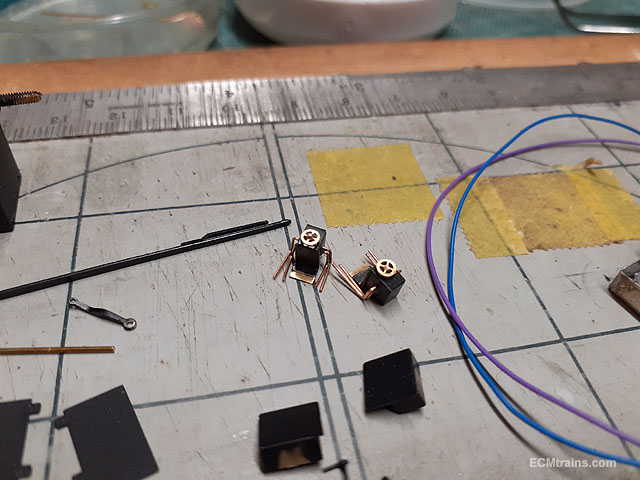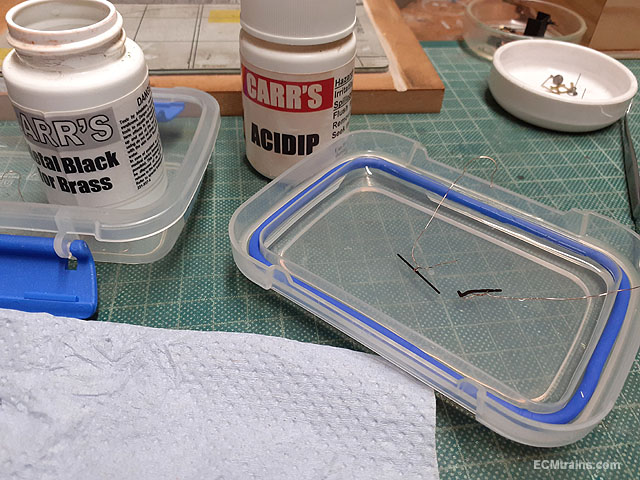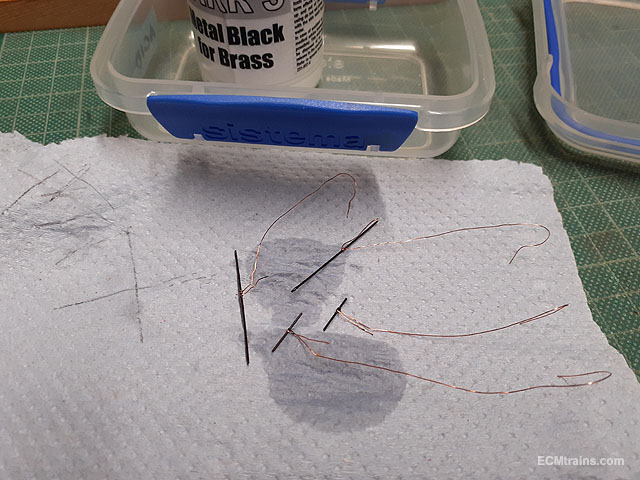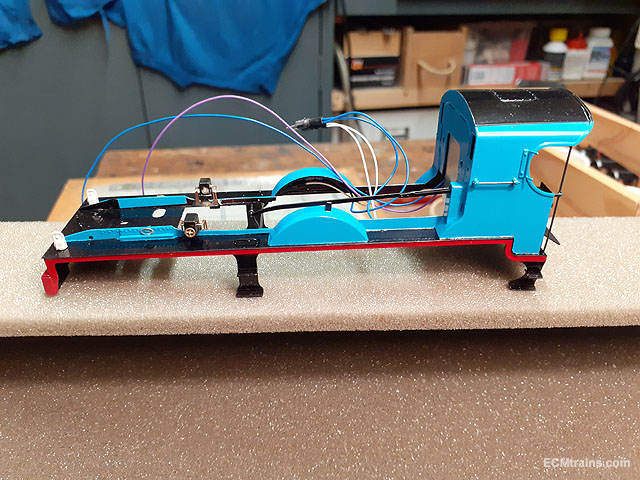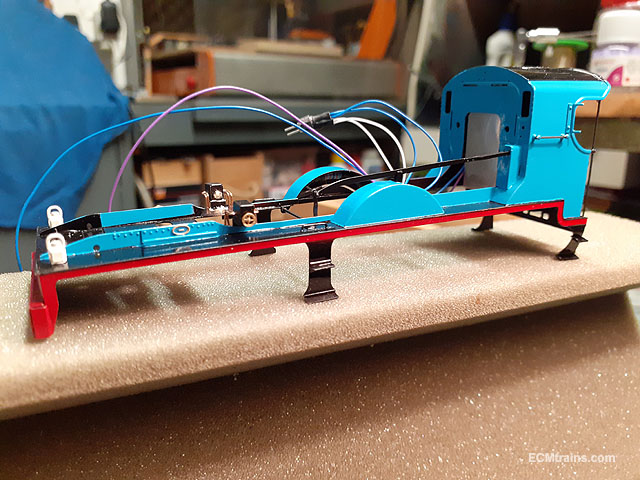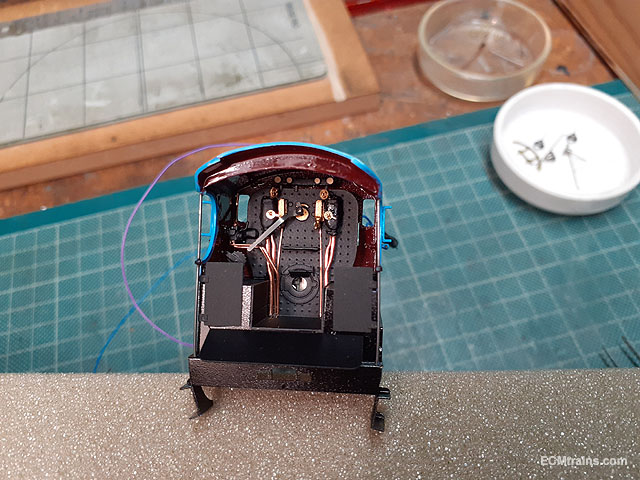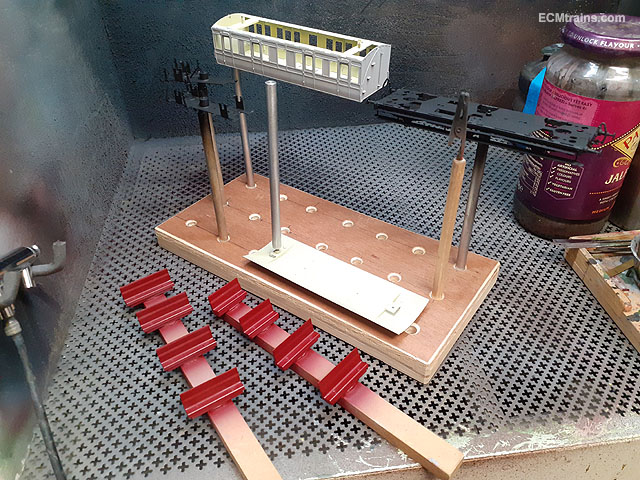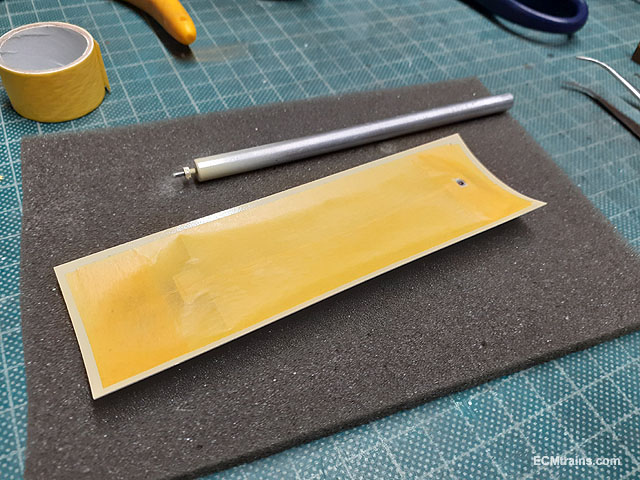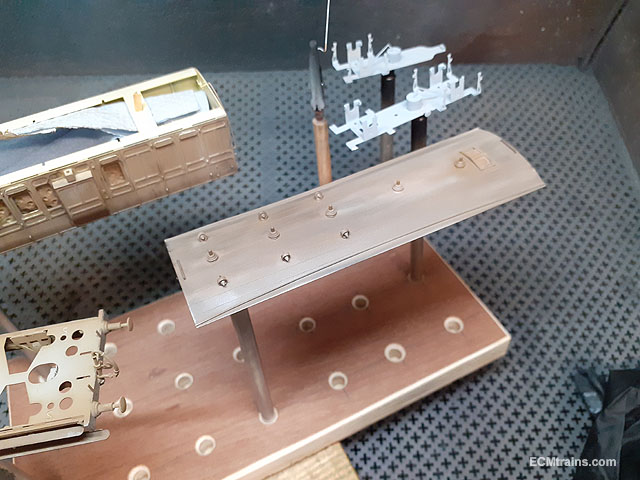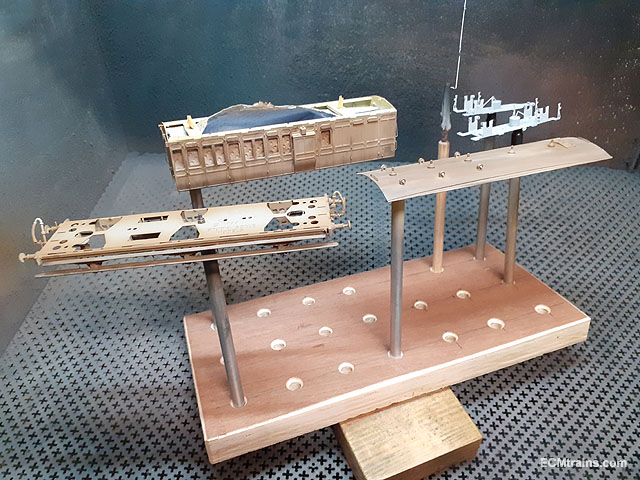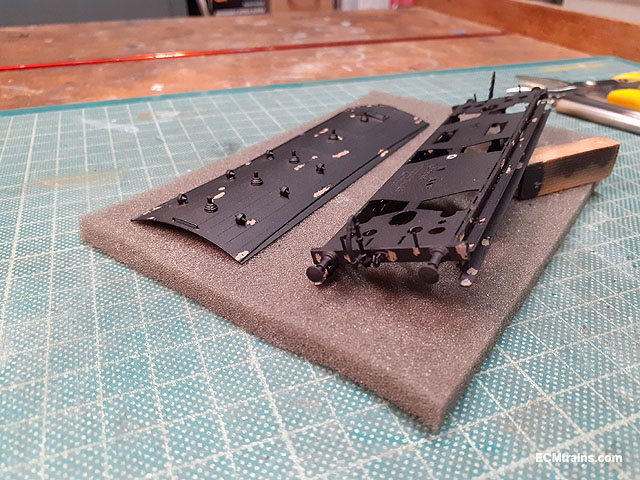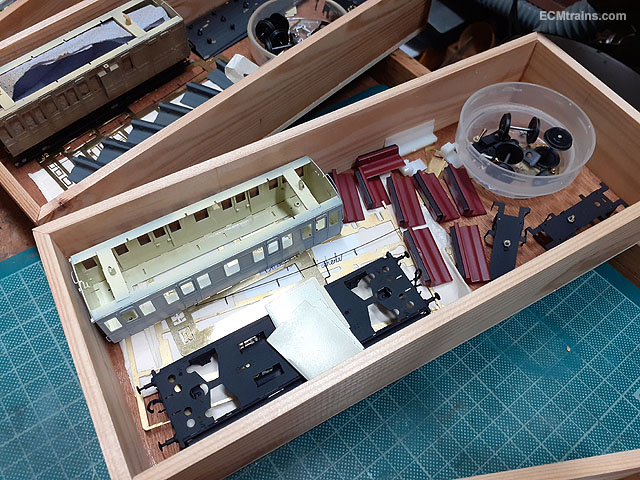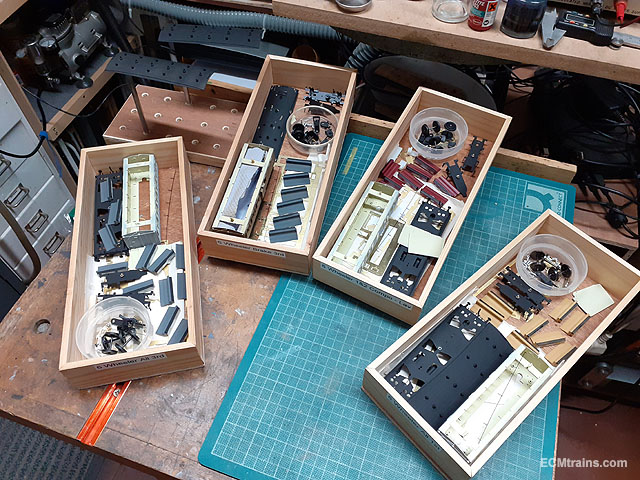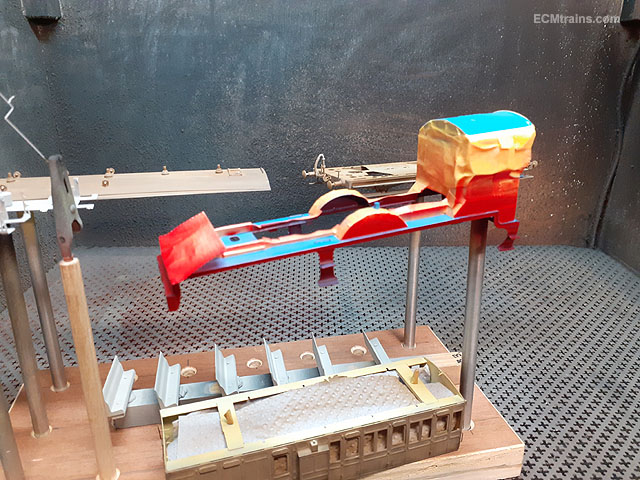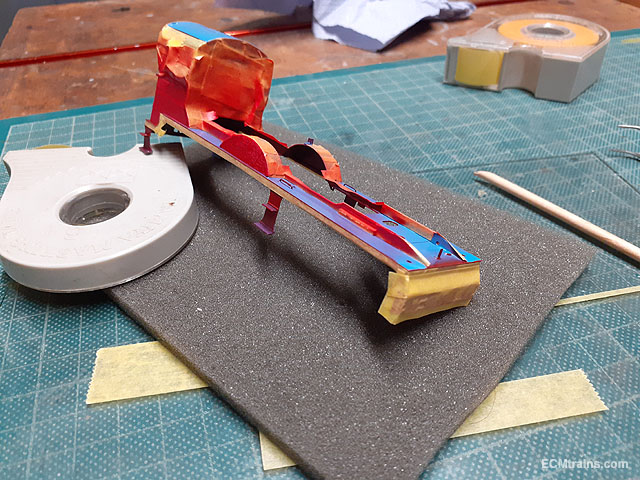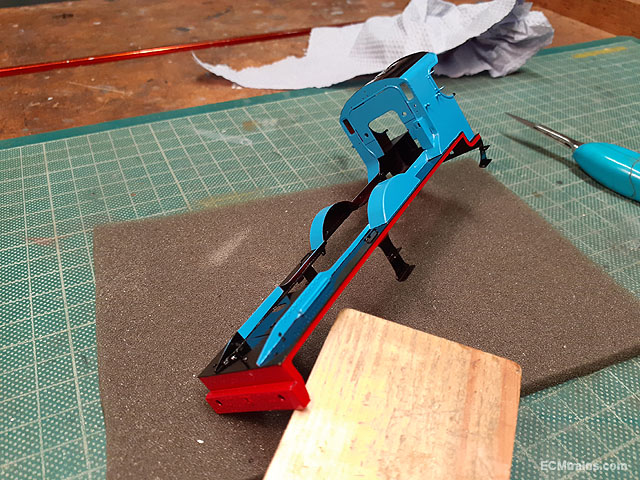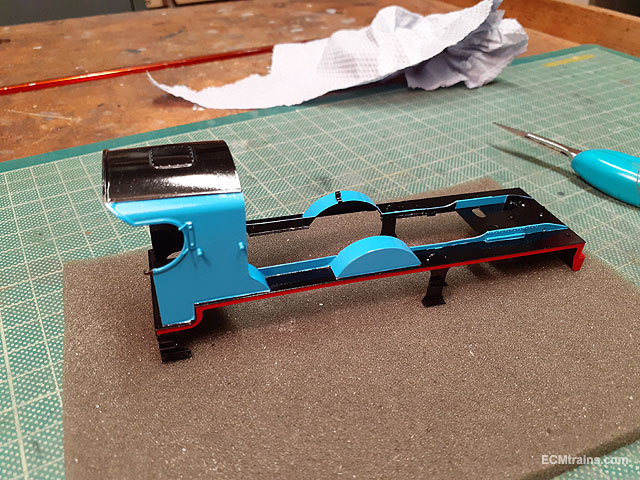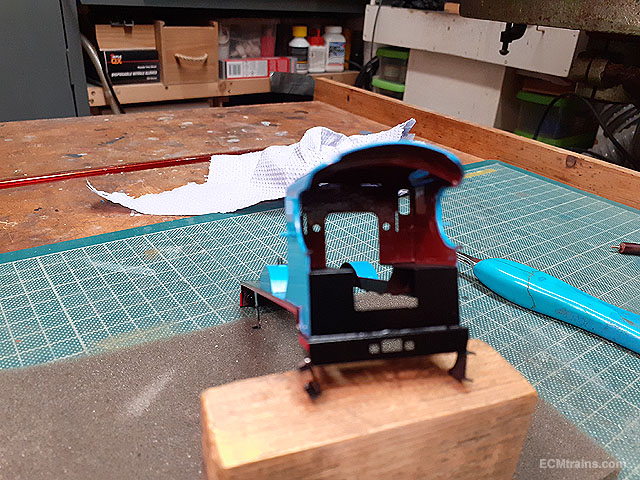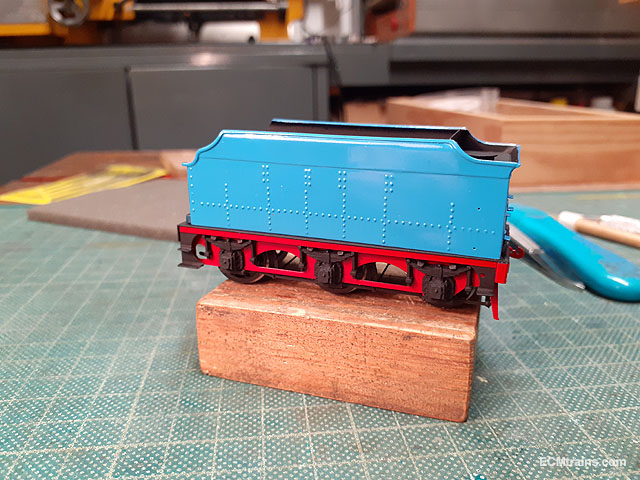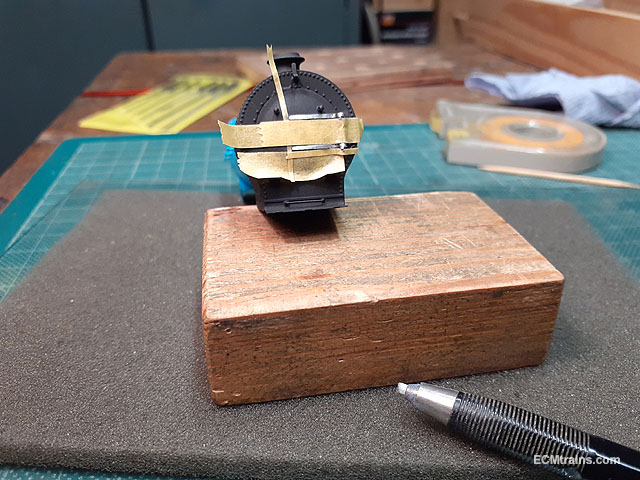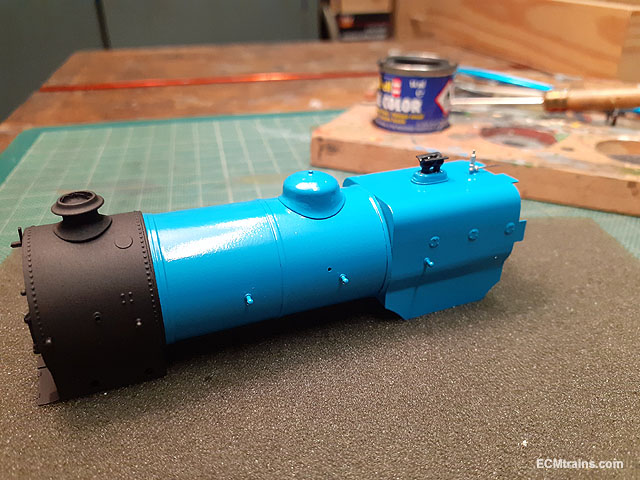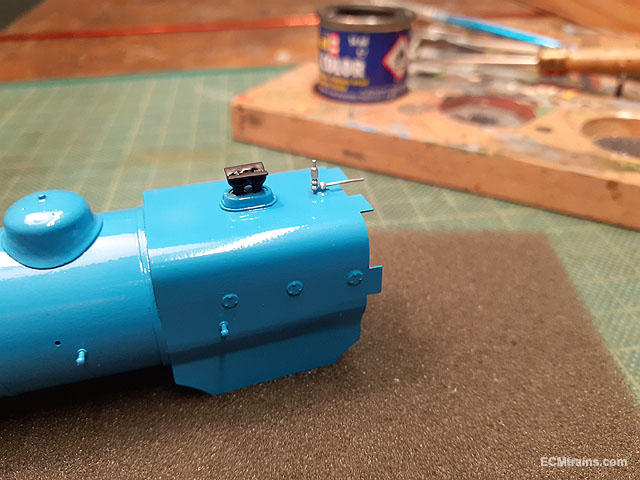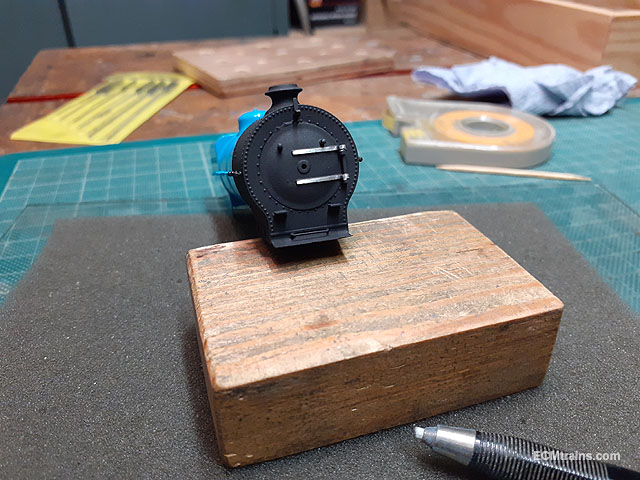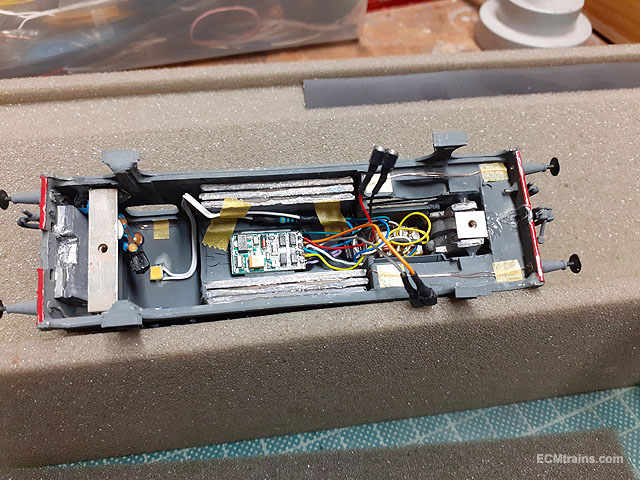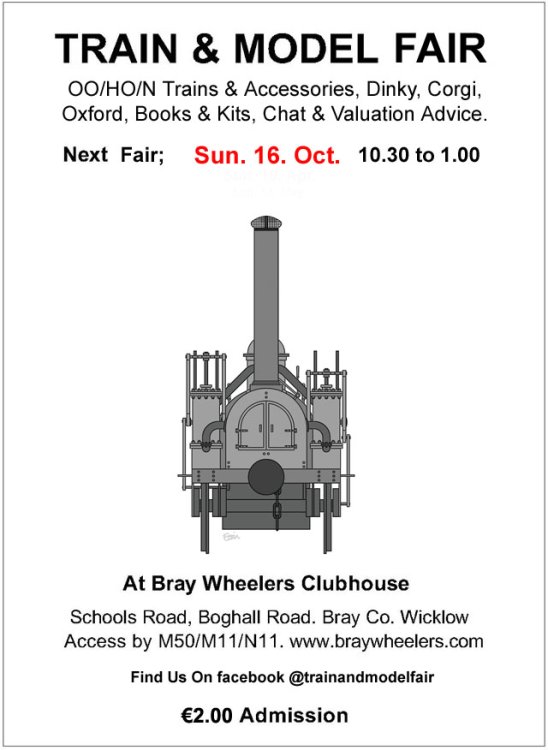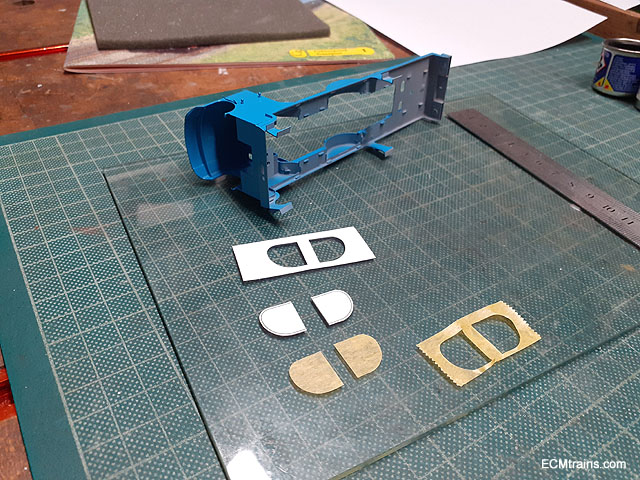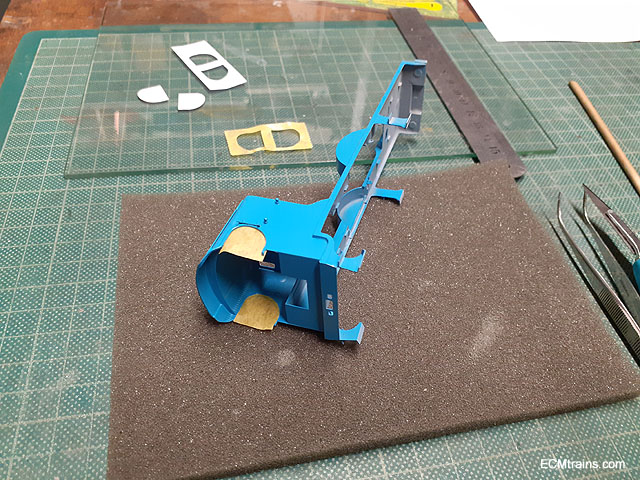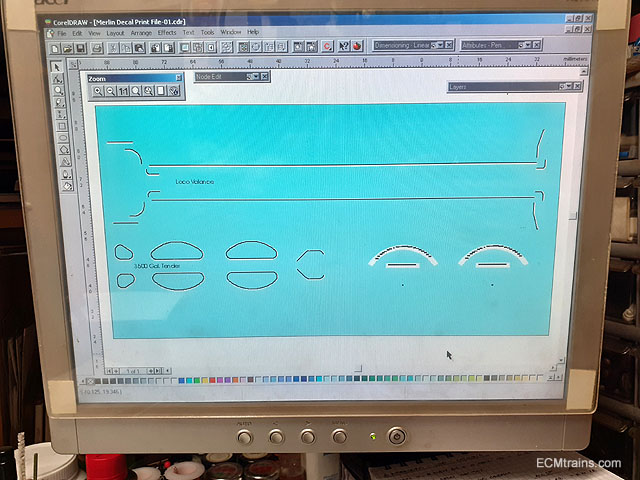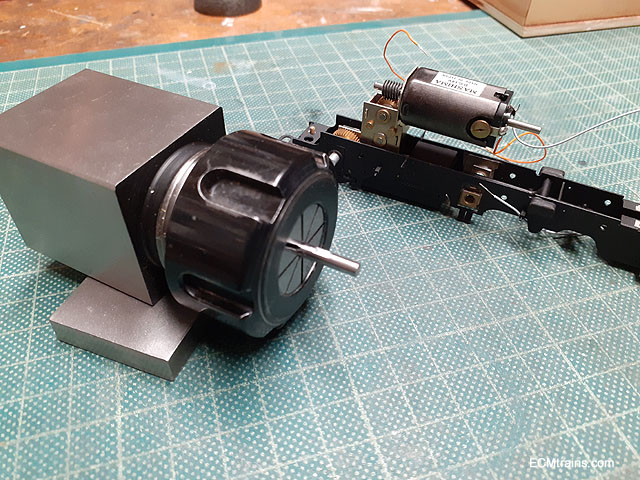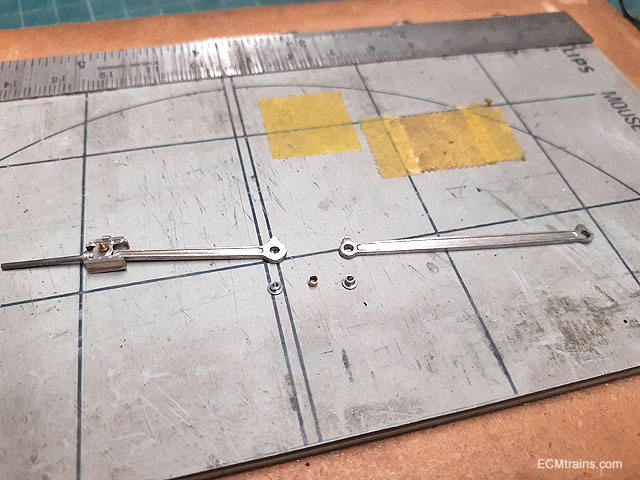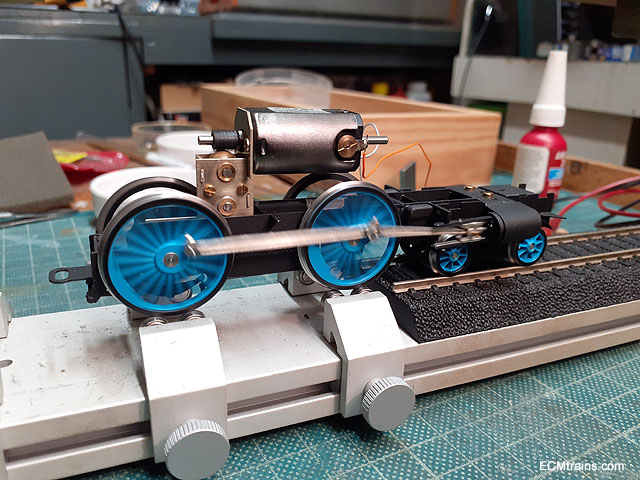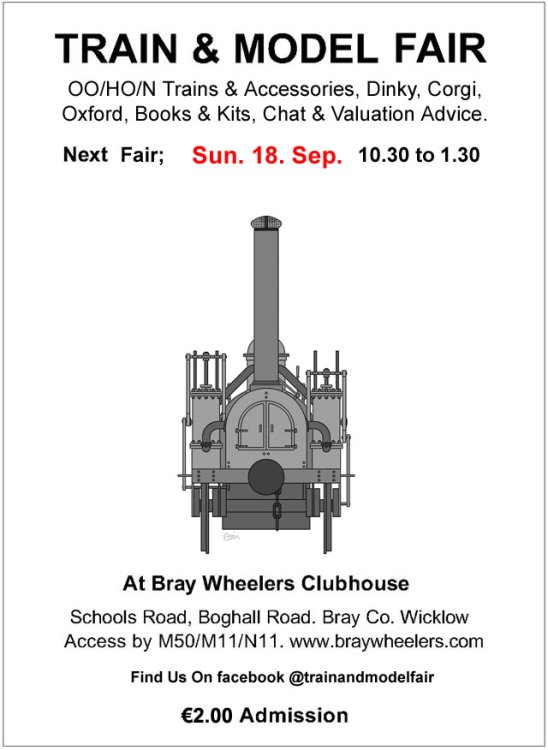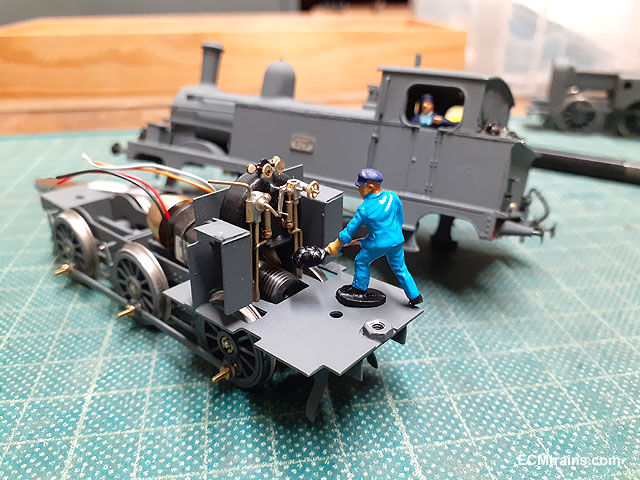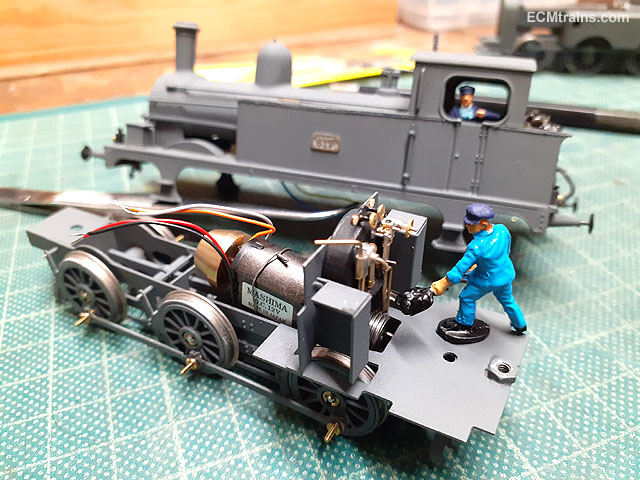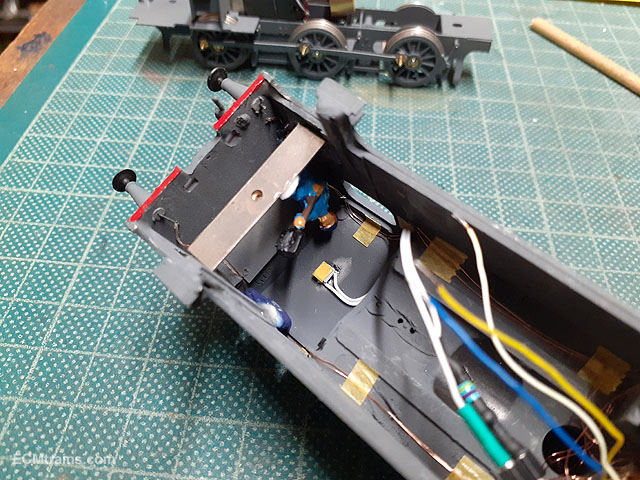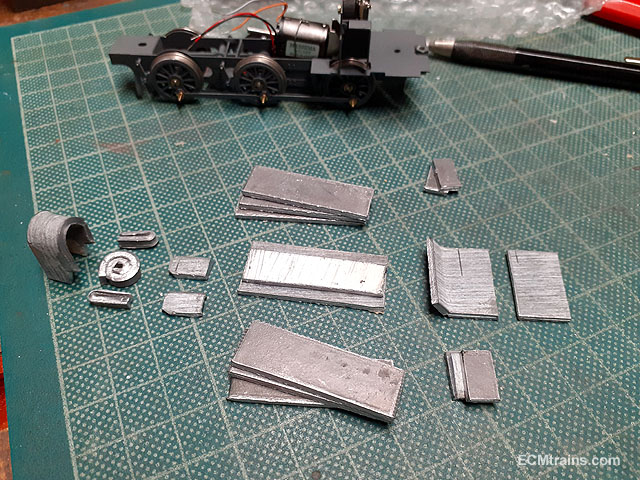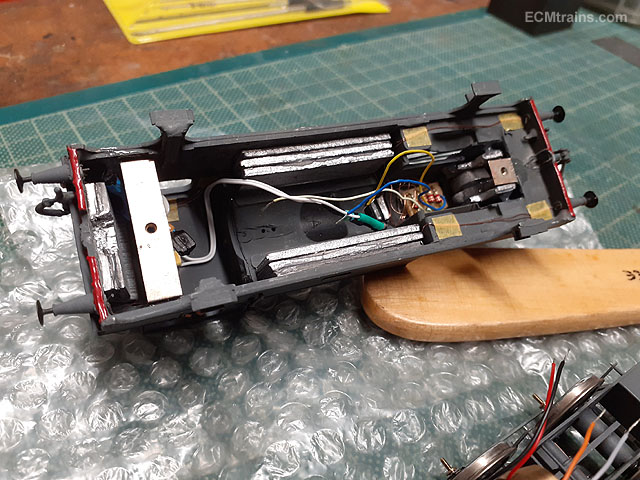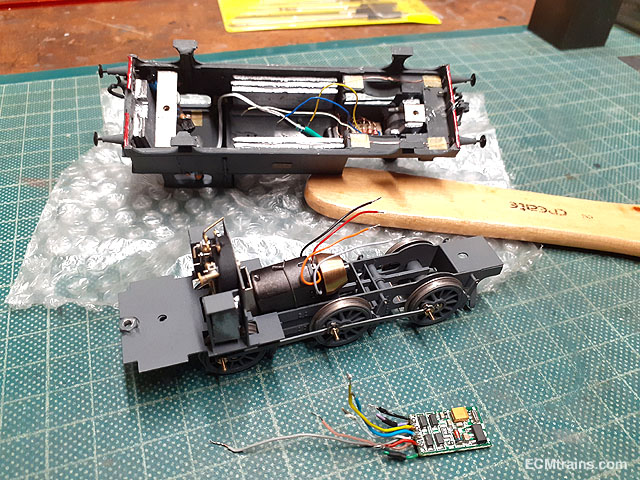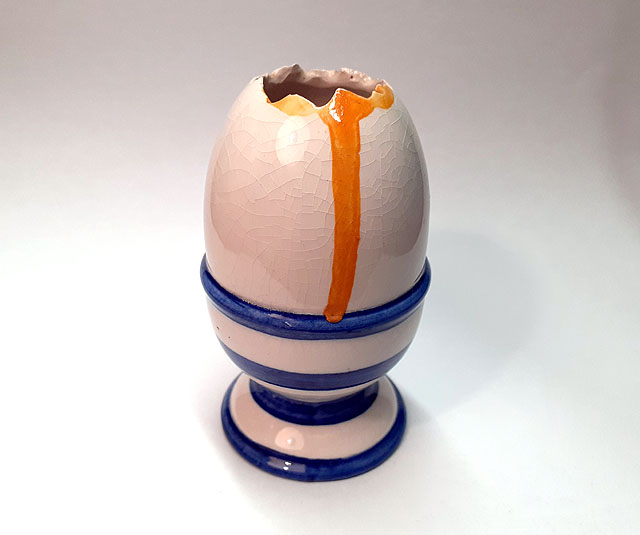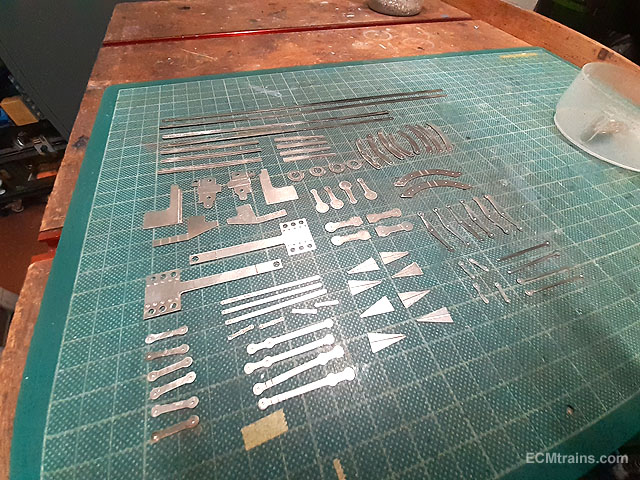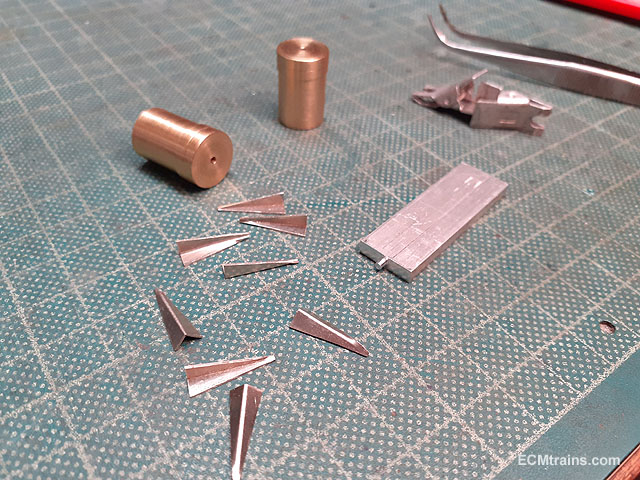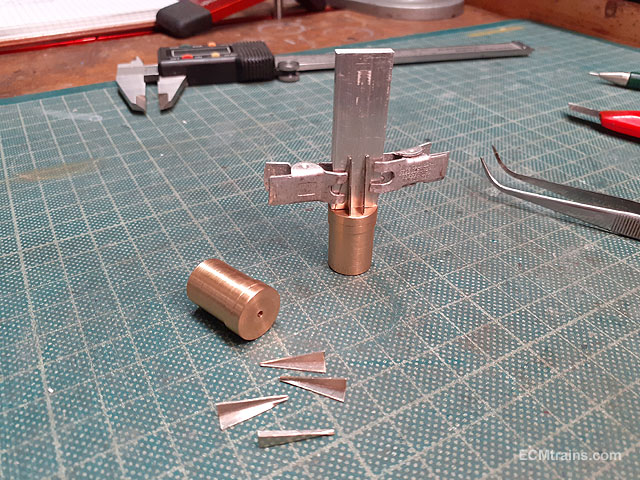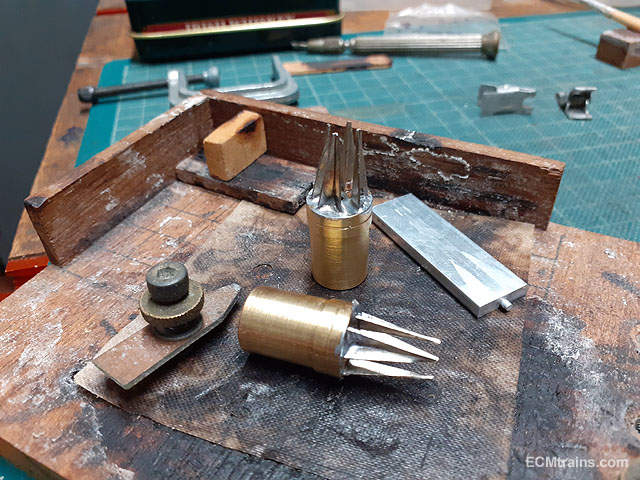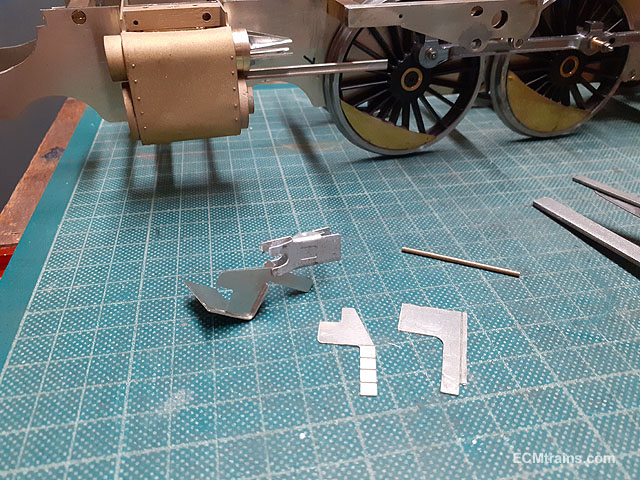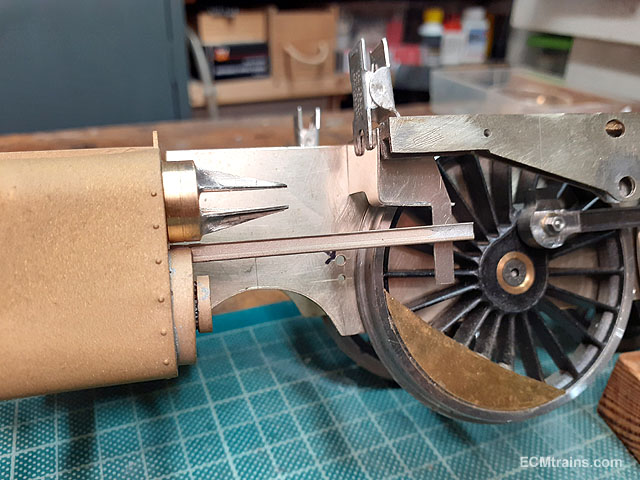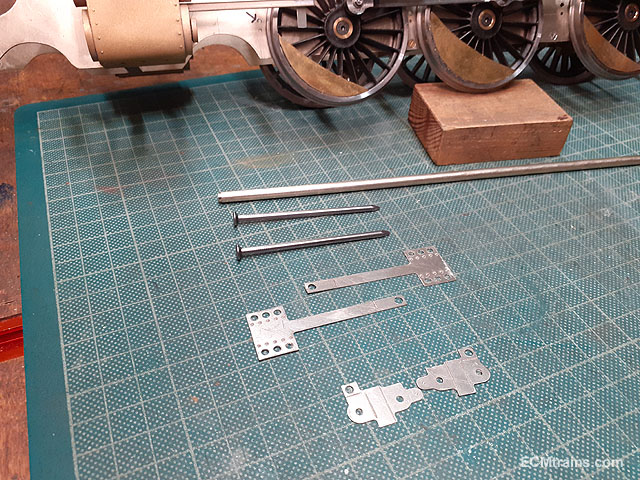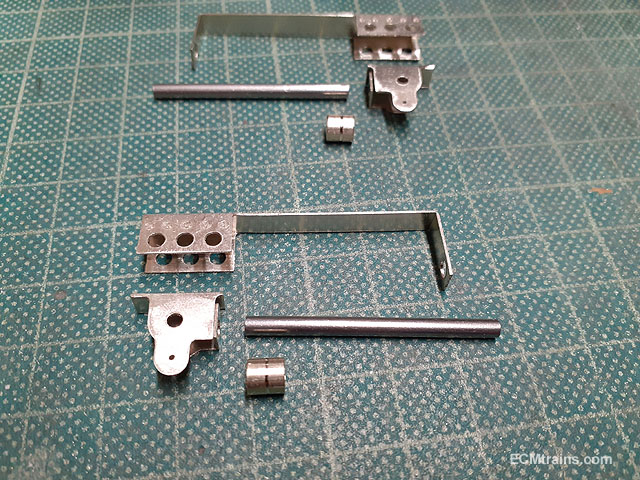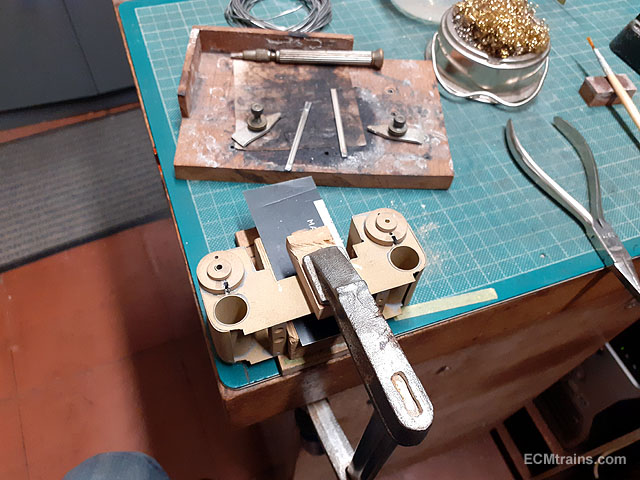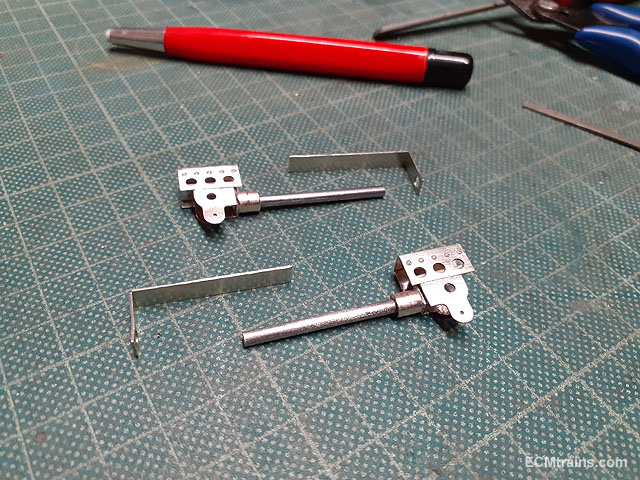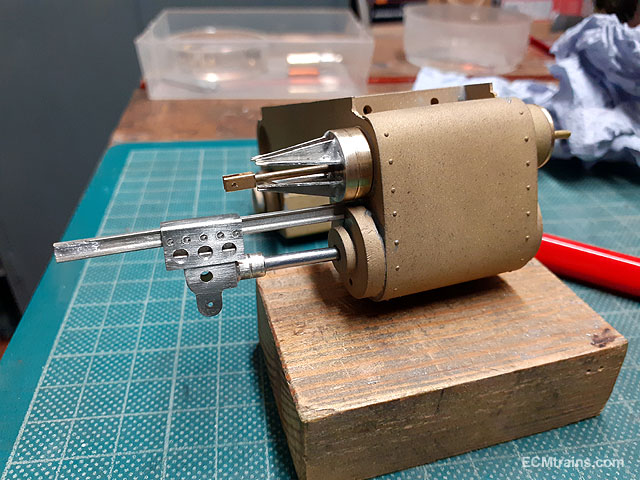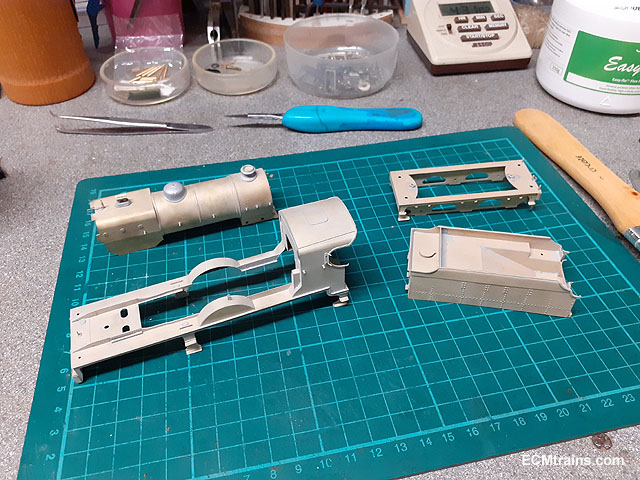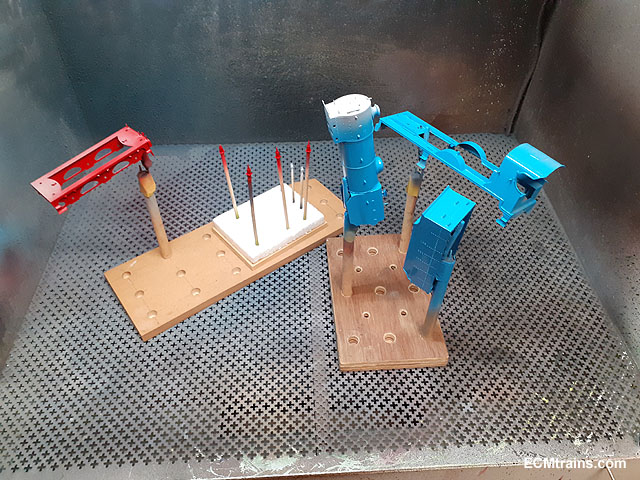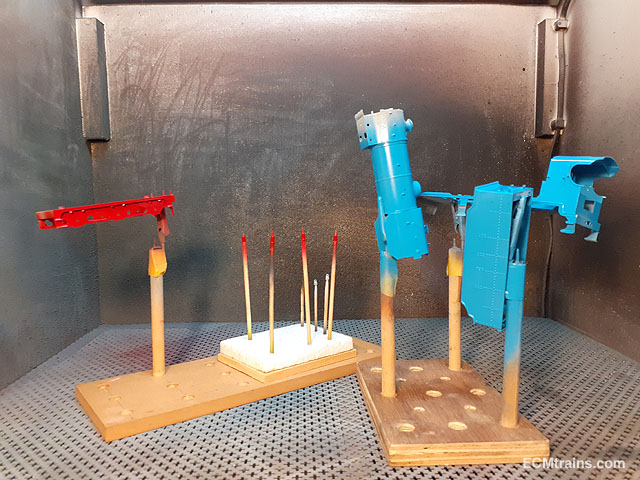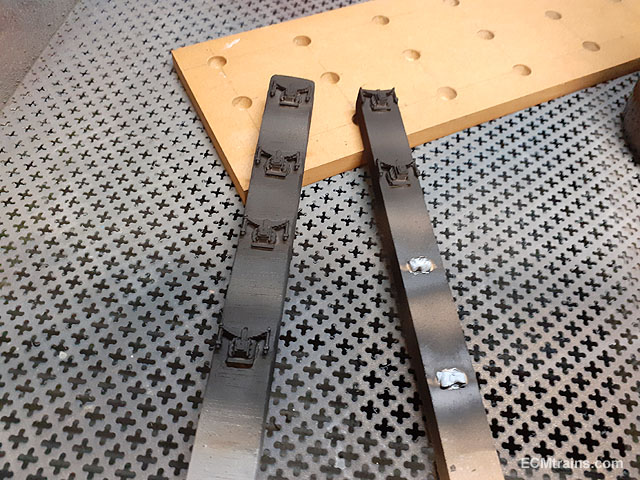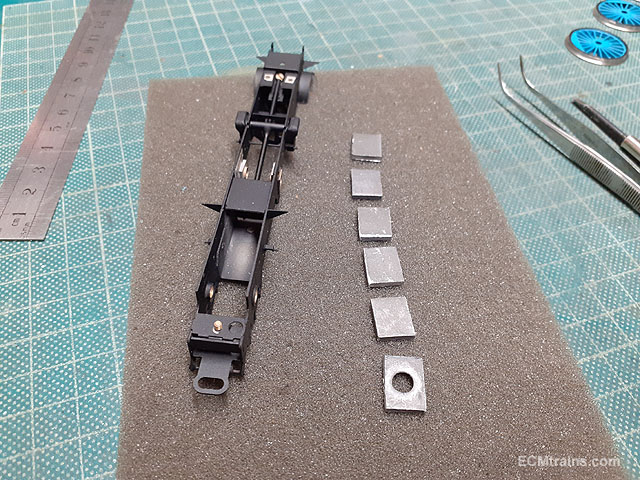-
Posts
2,731 -
Joined
-
Last visited
-
Days Won
70
Content Type
Profiles
Forums
Events
Gallery
Everything posted by murrayec
-
Decals going on- this is not for the faint-hearted or anyone with a pacemaker! The kits decals have some very fine lining and the sheet supplied with the kit had damage, so I sprayed some lacquer over them to try and hold it together. I also ordered a new sheet should disaster happen- and it did! 3 coats of satin lacquer applied. Started on the boiler first, strips of the lining were cut from the sheet and applied by wrapping the decal on the backing paper around the boiler, then applying water with a paint brush, encouraging the decal to slide off onto the raised boiler detail. The decals still broke up but with patiences I could get the bits to line up, overlaying small cut strips on top of the bad bits also works. The cab sides and the valance decals were cut into sections and applied, these will need some touching up. Same again on the buffer beam. I'm still waiting for issue of the valance decal sheet, described above some time back, to finish the back-end of the valance. This lining is tiny and brakes up into many bits! A few more bits to go....... Eoin.
-
I would use 2mm piano wire, as the drive gears need to be glued onto the new axles with Locktite- Locktite works best on steel rather than on brass. Eoin
-
Happy Birthday Wrennie Lots of Love, Eoin
-
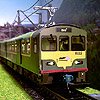
Two Axel Coaches in Ireland?
murrayec replied to Auto-Train Original's topic in Photos & Videos of the Prototype
-
@Dave Dawes You will have to replace the axles, the 141's axles are flush with the face of the wheels for 16mm track You may be able to push the wheels out on the existing axles- they will be overhanging though! Eoin
-
It came by truck and we had to bucket it in, up six steps to the patio level. Hard work but I had help. Eoin.
-
A bit of progress on the Myford project;- A very nice man has donated a metal shed for this project, I'm doing a reciprocal service for him. He insisted on providing a metal shed rather than using the wood I bought last year to do it. This is the type, but mine will have a double leaf door. After cutting out more of the bank around the patio we installed a type of retaining wall, consisting of pre-cast concrete fencing system to stop the clay falling against the shed walls. The long posts will allow for installing handrails to the ramp and steps- that at a later stage. DPM & 100mm floor insulation was laid on top of the patio slabs and timber shuttering was constructed for pouring a 100mm thick concrete floor slab. The concrete floor was poured last week, it was very hard to get a smooth surface finish because of limited access due to the retaining walls, so some remedial work is required- a floor levelling screed may be used after the shed is installed. The shed is due in a week or two? .......and yes, there will be some form of layout installed around the walls, Gauge O & 1 test tracks! Eoin
-
-
Setting up a wiring loom so that the body can be removed from the loco chassis in the future. With the LEDs epoxied into the lamp bodies its time to glue them to the running plate. Working out the wiring- I'm going to install the LED resistors in the splashers! Lights wired up. Testing. Time to install cab and running plate bits. The oil pumps have .3mm PB wire pipes and hand wheels epoxied on. Regulator handle being acid blackened. Cab handrails too. All epoxied on........ Eoin.
-
A short video of J10 running on the Greystones Layout;- Eoin
- 165 replies
-
- 12
-

-

GSWR/GSR/CIE Six-Wheeled Coaches - ECMbuild in Gauge OO
murrayec replied to murrayec's topic in ECM Model Trains
After a small little accident (not going to discuss here) we'r now back on track;- All the kits have had their interiors, partitions, seats, roof, chassis, and bogies painted. Some final filling on the brake/3rd roof where the birdcage was not installed. After the interior was painted cream the roof underside was masked off to paint the topside satin black. The black finish returns around the edge to the underside as the roof has a slight overhang over the body sides! This coach will be the worst kept of the 4 so a light wood brown under coat was used to simulate wood. Some weathering was was applied to give a bit of variation to the wood. Then lumps of maskol were applied to do the paint rip thing on the roof and the chassis. The body will be done later as the green paint is applied. Satin black top coat applied and Maskol removed, more weathering will be done later to complete the buzz. Just about to start the green........ Eoin- 68 replies
-
- 11
-

-

-
Masked off and painting the read buffer beam & valance. Masking off the red and blue to paint the cab roof, the running plate, and the underside satin black. Black done. Cab painting complete- out of focus! The tender chassis assembled with electrical pick-up installed and the outer frames have the springs epoxied on. Looking good. Smoke box door straps masked off while removing paint from the straps with a fibre brush. Done. Safety valves and steam deflector are painted black. And the whistle had the blue paint removed back to brass. Eoin
-
I eventually came up with a plan for the chip location, as seen above. The body can be disconnected from the chassis by mini connectors if needed. With the body on and those crank-pins trimmed it ran fine on the test track. This completes the chassis build- eventually! I will take some video on it's home layout and post it up here when done Complete! Eoin
-
Wheeltappers do a version of the 071 sounds based on the ESU chip, if one is going to use the Locprogrammer it is best to stick with compatable sound chips- ESU, the Zimo chip system has it's own programmer and most likely it's own convention for programming so may not be compatable with the Locprogrammer. Most sound chip manufacturs have their own programming systems and are not cross compatable? The Wheeltapper's chip is £133.00 and would be the best starting point if going for ESU, the chip is already programmed so that helps. The pitch of the sound is mainly down to the type of speaker or speakers used, big base speakers are best but will require more fettling to the model........ Eoin
- 22 replies
-
-

How are Murphy Models Craven Coach Windows held in place?
murrayec replied to kevin_gal's question in Questions & Answers
@kevin_gal Craven glazing is heald in by the lugs in the ceiling and the flush glazing design, when the coach is assembled the floor locks into the glazing to hold it in place. If the glazing is falling out of place while trying to fit the floor and chassis- a small dab of non bluming cyano glue on each end will hold it in place. Eoin -
well, more technology problems- after the phone memory wiped it's self, my workshop/internet computer's power supply decided to follow suit with the phone and go up in smoke! It's an oldish machine but luckly I found a man that could source a replacement power supply. I lost a few photos of the work on this kit, not very important stuff- just masking for the black painting and the chassis assembly. Satin black done on tender body and the loco smokebox. These are cab internal masking bits for painting the cab interior. The cab interior is painted a red/brown but the cab side beading is blue on the inside so these masks should aid doing that. When I went to the kits decal sheet for the tender chassis lining- there was none! I then noticed there was'nt any for the loco valance also! So I prepared artwork to have them printed and awaiting return. Do you like my Windows 2000 setup..... Gearbox drive axle with flat milled for grub screw seat. Chassis wheeled up and quartered. The crosshead slide bars needed a bit of fettling- removing the paint to get smooth running. The crankpin set supplied with the kit did not have long bearings to take the coupling and connecting rods on the one pin, a small bit of brass tube was used temporary until I find long enough bearings. The connecting rods were bent a little at the boss end as the rods are at an angle out to the crosshead, the bend keeps everything straight on the crankpin bearing. Motion gear up n running smoothly under power. Eoi.
-
-
I think it's going to be an oil squirter too, better make a shroud for it or it will mess up the backhead controls! Eoin.
-
On the final stretch now! After assembling the chassis and giving it a test run to adjust the coupling rods the driver and fireman turned up to lend a hand. After checking the fit of the fireman he was then epoxied onto the body-to-chassis fixing bracket, a LED cab light was also fitted. A bit of masking tape is placed over the LED to dull and yellow the light. About 100 grams of lead weight was chopped up- sized to fit on the inside of the body. The main weight being centred over the back axles. Weight epoxied in. The final problem- fitting the chip and wiring in there somehow.......... I did have a video of the loco running on the test track but my phone's memory card had a bit of a melt down and it was lost, along with other stuff ''Backup you phones'' Eoin.
- 165 replies
-
- 11
-

-

-
-
Eventually I got all the parts out of the sheet. First up was the steam valve crosshead frames, the parts were folded up 90deg and a soldering jig was turned up from aluminium stock. The jig slots into the valve bore, the crossead parts are clipped on both sides and butted up against the brass valve part. Soldered. Both done. These are the hangers to hold the end of the slide bars on the main crosshead- one is ready for soldering. Hangers soldered up and test fitted to the chassis, the slide bar end will be held in the hanger which is not folded yet! I first need to assemble the crossheads and conrods to check alignment of all these parts. The parts for the main crossheads - including 4mm dia NS bar for turning up conrod sleeves and two 2.8mm wood nails to make the conrods. Parts folded up, sleeves turned and nails cut- the extensions on the slide head is a alignment jig to hold the conrods while been soldered into the crosshead. The holes in the main cylinders need to be opened up to 2.8mm dia, so the slide bars had to be de-soldered from the cylinders to allow for this. Crossheads clamped and soldered. Jig bits removed and parts cleaned up. Testing fit, all is OK, but have to make a decision on the slide bars now. These were made from a bit of NS track! Now that I have them removed I think proper slide bars should be made- back to the drawings....... Eoin.
- 30 replies
-
- 10
-

-

-
Painting continues;- Loco and tender body parts sandblasted. Etch primed. Undercoated and colour started, there's going to be some complex masking to do the black on these parts! Tender chassis springs painted. Starting to assemble the loco chassis, first is to install some lead in the ash pan under the motor. This is done with 10x11x1.7mm sheet lead stacked, which will be epoxied into the pan in front of the gearbox. The one with the hole in it is for the bottom of the stack to allow for the captive nut which holds the electrical pickup board on the underside....... Eoin.
.png.c363cdf5c3fb7955cd92a55eb6dbbae0.png)

